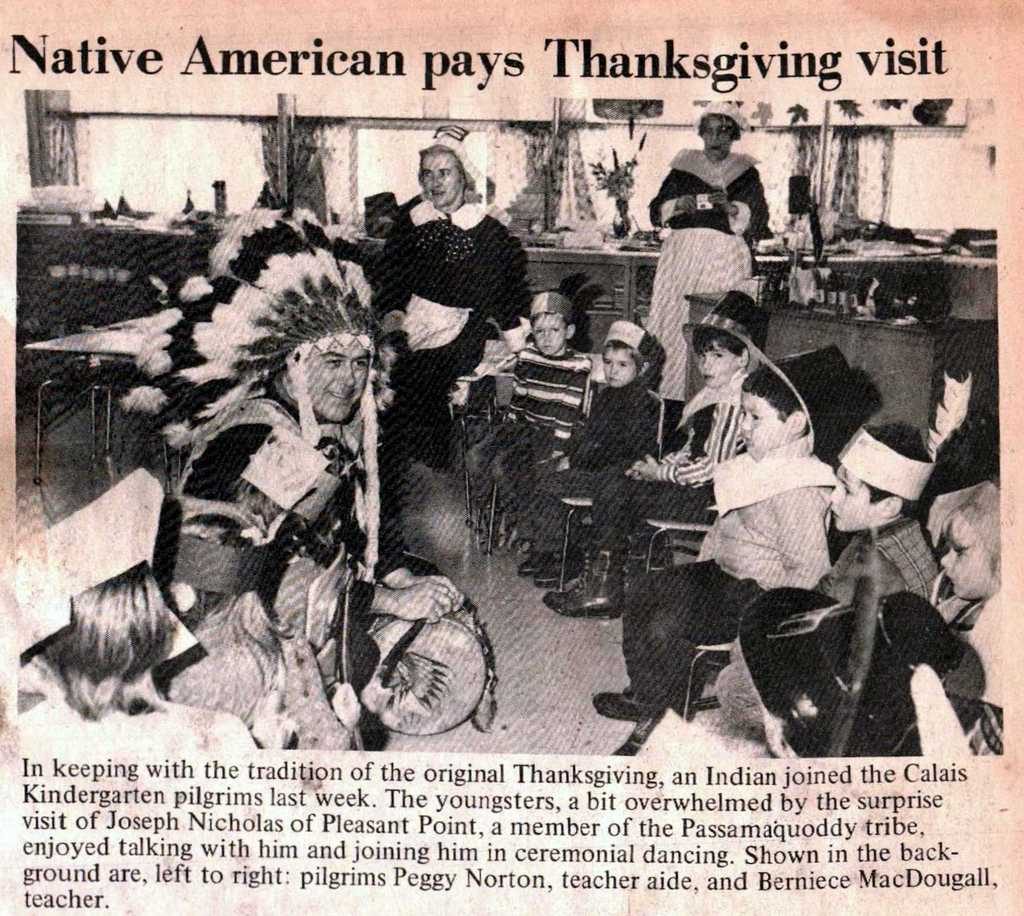
Joseph Nicholas of Pleasant Point is shown above entertaining Bernice MacDougall’s kindergarten class at Thanksgiving 1974. Tribal Representative in the Augusta, holder of nearly every important tribal office locally and noted humorist and raconteur, Joe was a much sought-after speaker, including at Historical Society meetings where he never failed to entertain his audience of “palefaces”, his favorite term for describing our members. At one meeting he described with some relish the “seal nose scam” of the early 1900s which involved the tribe using its skill as both hunters and artists to collect thousands of dollars in seal bounties from towns in Massachusetts and Southern Maine while conserving the seal population upon which the tribe relied for both clothing and food. While admitting to the unlawful nature of the Tribe’s conduct he offered no apologies, pointing out that we “palefaces” had taken nearly all of the Tribe’s hunting lands, restricted hunting and fishing on what remained and left the Tribe with only the Bay of Fundy for sustenance and then only subject to onerous regulations. To make matters worse the “palefaces” decided it was necessary to eradicate the seal population entirely to protect the commercial fishing industry.
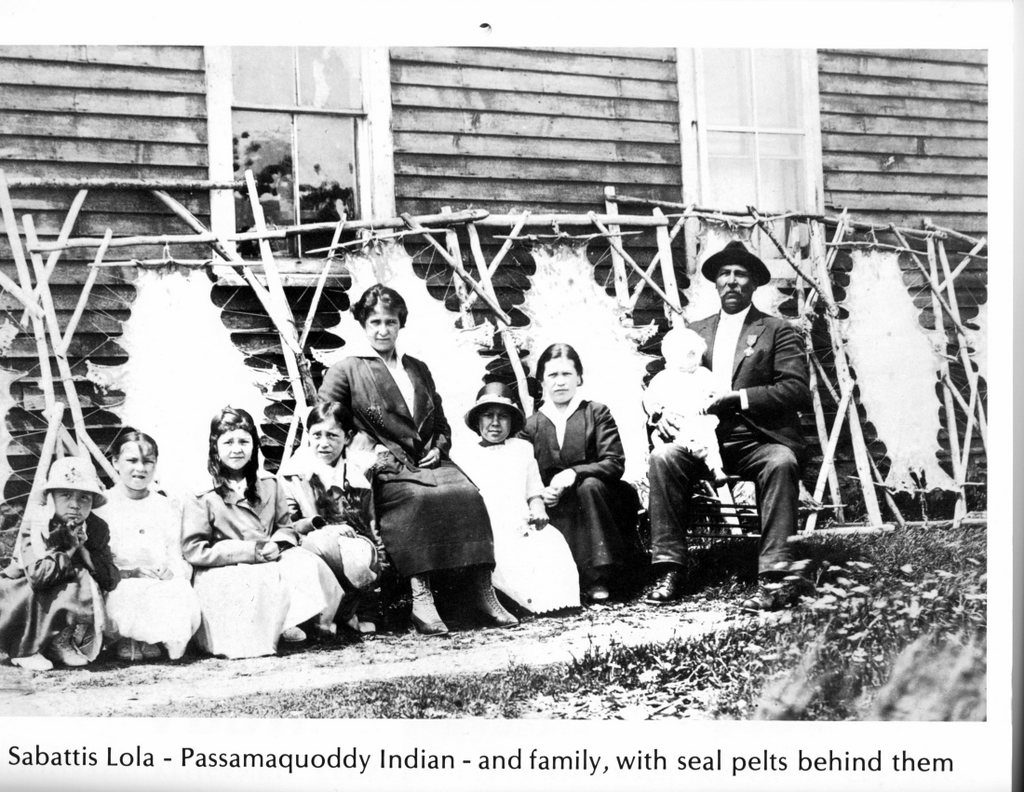
Donald Soctomah, Tribal Historian puts it best:
Much of the land was fenced, rivers were filled with logs, access for the Passamaquoddy people was not as easy as in the days of old. Dams stopped the flow of water, and the migratory fish were blocked from their breeding grounds. Every tree that is felled in the forest reduces the area of the hunting grounds, which the Tribal people inherited from their fathers. Every day he sees the girdle of fields and meadows narrowing the circle of his hopes. Driven back, mile by mile, they became strangers and aliens in their own land – outcasts, robbed of their birthrights by another race. He and his Tribe are but a few, and their efforts avail nothing against the ceaseless advance of the white race, who come welded together into a resistless forge by the iron hand of civilization. It was only on the ocean that the tribe could find the freedom that was in their blood; no one bothered the ocean hunter.
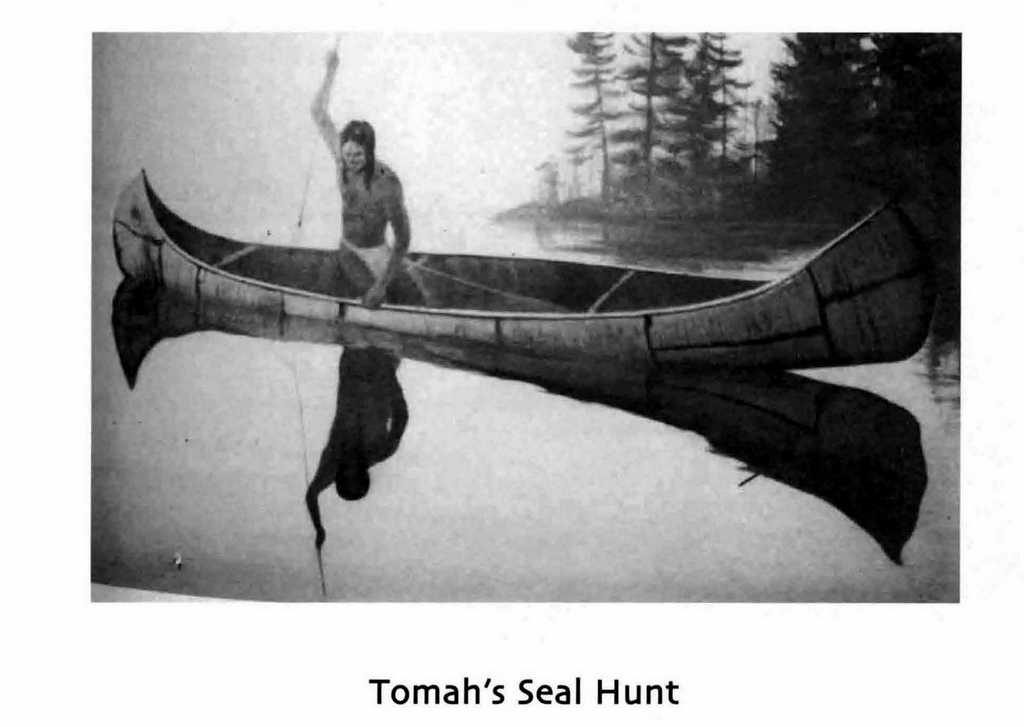
Donald Soctomah describes Tomah, a typical seal hunter of 1900:
Tomah looked at the month of June as his favorite time to hunt seals, and to travel around the Bay of Fundy. Many men of the tribe are expert hunters of seals and other ocean creatures. Every season they start off in their frail birch bark canoes of 18-foot length far into the treacherous waters of the Bay of Fundy. On last season’s trip Tomah harvested 38 seals. It was below the average as seals were becoming scarce and more difficult to hunt in recent years. Sometimes the hunters secured 50 to 60 seals. The expert hunter of the Tribe started off recently with canoes loaded with bedding, tents, cooking utensils, a small supply of food, guns, harpoons and limited supplies for several weeks.
While using their light paddles often on the trips, each canoe is fitted with a tiny sail and, when winds are favorable, it saves time and their strength as the canoes were loaded nearly to the limit. The craft ride deep in the salt water and could not be handled safely excepting by Indians who are noted paddlers and sailors. It is not necessary to take along much food as plenty of seabirds are available when the hunting grounds are reached. Millions of herring of many sizes swim in the Bay of Fundy. Cod, pollack and haddock are easily caught on hooks. Lobsters are always to be secured. Other kinds of shellfish can be found by Tomah when on his trips, so food problems do not bother him. Many seal hunters like Tomah would camp on small islands and pitch their tents to remain for a few weeks. During the seal-hunting season there are many seals to be found on rocks and ledges in the sun. The mother seals watch carefully over their young and, on the approach of strangers, gather up the little ones under their flippers and quickly reach the water for safety. They will fight for the protection of the baby seals.
The Tribe harvested seals to provide food and clothing and only in numbers that did not endanger the seal population which by the late 1800s was stable, too stable for the fishing interests on the East Coast. The seals it seems were eating far too many fish. Even newspapers such as the Mexico Missouri Daily News reported in 1897:
A seal with a normal appetite will eat 20-25 pounds a fish a day. It doesn’t take a very large number of seals to produce a fish famine of no small proportions.
If the folks in Missouri, which is as far as it is possible to be in the continental United States from a seal, were concerned about a “fish famine”, you can imagine the panic in the fishing community on the East Coast. The solution proposed was to eliminate the seals by paying a bounty for every seal killed and Maine, New Hampshire and Massachusetts dutifully acceded to the demands of the industry by requiring the town clerks to pay a bounty of from $1 to $3 dollars for each seal nose or tail, depending on the State, presented to the clerk. Naturally the disparity in the laws led to some chicanery- tails or noses of seals in a $1 jurisdiction found their way to the clerk in a $3 town and, as a seal has both a nose and a tail, it was possible to collect twice.
Still, it was the Passamaquoddies who took seal bounty collection to dizzying heights and they did so while remaining true to tribal tradition which prohibits the killing of any animal except for sustenance. Skilled Passamaquoddy crafters and artisans found they could convert one seal hide and a few whiskers into a hundred “sea noses” and present them to gullible town clerks in Southern Maine and Massachusetts for the bounty. The scam worked well, so well in fact the market was flooded and the scam collapsed when the Portland Town Clerk, suspicious after forking out larger and larger sums for seal noses took a much closer look at the “seal noses.”
The Eastport Sentinel of January 27, 1904, reporting on articles which had been printed nationally, summarized the collapse of the “seal nose” scam:
MANUFACTURING SEALS’ NOSES FOR THE BOUNTY OF $1. EACH.
It appears from the following report that appeared in Portland papers on Tuesday of last week, that some of the Passamaquoddy Indians have been doing a flourishing business making imitation seals’ noses for the bounty of one dollar each paid by the state. It is said that one Indian who has camped upon the islands in Casco Bay has been paid upwards of $1100 by Portland’s city treasurer during the past year for seals’ “noses.”
Louis Sopiel and Joseph S. Dana of the Passamaquoddy Tribe are under arrest in Portland, charged with manufacturing seals’ noses. Their arrest is of sensational interest as it discloses what appears to have been a wholesale system of defrauding the state by bringing in what purported to be seals’ noses and collecting a dollar each on them.
It was City Treasurer Dyer’s good fortune to be instrumental in capturing these two fellows. They had eighty-six “noses” that had been made by cutting out pieces of seal’s skin, sewing bristles in for whiskers and then slitting openings for the nostrils.
Scores of people called at police headquarters and have been amused at the odd ingenuity which they have exercised in making these bogus “noses.” The bristles are sewn in and a knot on the end holds them from falling out, but a sharp yank draws them through the hide and then it is seen that they never grew there. The nostrils are apparently genuine until careful examination is made. While the deceit is clever, it is also crude and apparent now that it has been discovered. The seal’s whiskers taper to a delicate point. These were stiff and blunt, unlike the real article on close inspection.
As they receive a dollar each for the noses they bring in, it can be seen that this subterfuge was easier and more profitable than the tedious and tiresome pursuit of the animals along the rocky reefs and ledges of the bay.
City Treasurer Dyer, and his predecessor, have paid to bounty seekers $2,642 in the last year. Suspicion arose that there was a flim flam process on and so Mr. Dyer became watchful. It so happened that he was prepared to test the matter when the Indian Sopiel came in Tuesday morning. He produced eighty-six “noses” and signed the voucher which specifies that he killed that number of seals. This will be evidence of attempting to obtain money under false pretenses.
Mr. Dyer gave Deputy Marshal Frith a telephone tip and that officer came upstairs. In the corridor was another Indian, Dana, who was carrying a bundle. Deputy Marshal Frith tipped off Officer Fickett to take him in and that officer did so immediately. When the deputy marshal went upstairs, he was told that this stranger had some noses to be redeemed and he looked at them. It was evident immediately that not one in a score were genuine and so he invited Sopiel downstairs.
There the whole fraud was exposed. Sopiel says that about all of the adult Indians of the Pleasant Point tribe make most of their money by sealing. They get one seal and by judiciously cutting and pasting they make about a hundred “noses” which they present to the municipal officers in various towns along the coast. They figure that the mess of seal noses is such a gruesome looking mess that most of the town officers would rather pay and burn them and say nothing than stop to handle them over and to verify the count and to make sure that they are real seals and not manufactured ones.
The Indians say that the treasurers of almost all of the towns and cities alongshore from Eastport clear down to New York have been imposed upon in this way.
County Commissioner Wiggin said that recently two strange Indians called on the town treasurer of Freeport with over 200 “noses” for which he had paid the regulation dollar apiece. It would probably turn out that these “noses” were made ones, but as they were immediately burned there is no way to tell the truth of the matter.
A man who is familiar with the entire bay says that he does not believe that half nor a third of the noses brought in by the Indians have been genuine. The names of all the Indians who have secured bounties from the city of Portland have been obtained by the police and an effort will be made to round them up and explain how many seals they have shot, and a lot of other interesting information will be sought also. It depends upon testimony which the officers are after what sort of a charge will be brought against the Indians who are held in the police station now and what will be done with them in court.
Two were brought in at Bangor last week on a like charge. They had been collecting money so fast that it aroused suspicion and the town authorities began an investigation. They found that the “noses” were identical with those which were found at Portland. It is likely that every nose that comes in now, after this alarm shall have spread abroad, will be “held up to the light.”
The discovery and positive exposure of the fraud is likely to finish the wholesale “slaughter of seals” that has seemed likely to exterminate the animal along the coast. As a matter of fact, it is likely that no appreciable inroads have been made in their ranks; that one seal has been able to produce 100 noses.
The objection to the poor seal is that he is a fish eater. For that reason, the State of Maine caused to be enacted a law which was looked upon to lessen the vast families that were supposed to populate the harbors, rivers and inlets along the coast and raise havoc with the fish which the fishermen have been after.
Frank Atien and Sabattis Newell were arrested last Wednesday morning in City Hall, Portland, after having made oath to the city treasurer that they had in their possession 100 seals’ noses to be redeemed at one dollar each. It was found that they are bogus “noses,” similar to those which were confiscated from Sopiel and Dana. Tuesday. Accordingly, they will be arraigned on the charge of attempting to obtain money under false pretenses.
Some national papers applauded the ingenuity of the Passamaquoddies. The Oklahoma Pond Creek Daily headlined a story:
The Wolf-scalp Industry Outdone:
The ingenious boys of Western Kansas and Nebraska, who several years ago raised young wolves in order to get the liberal State bounties, the courageous men who maintained skunk farms in order to profit from these fur bearing but malodorous animals, must yield their laurels to the Indians of Maine…”
The article goes to describe the beautifully crafted fake noses which had deceived the town clerks for so long. Even Massachusetts papers were quick to point out that the residents of Pleasant Point were not alone in collecting less than righteous bounties. The State paid money to many farmers who claimed phony “deer damage” to crops and for dead sheep whose “carcass was moved from place to place by a farmer until it was inspected half a dozen times” and damages paid each time. In fact, bounties always bred schemes to drain the government treasuries and rarely accomplished their purpose, the “seal nose’ scheme was just one of the more ingenious.
One would have thought the collapse of the “seal nose” scam of 1904 would have taught those imposing bounties a valuable and enduring lesson especially as regards the harbor seal. Not so. Only four years later, in 1908, the “seal tail” scam cost Massachusetts even more than the sea nose scam had cost Maine in 1904.
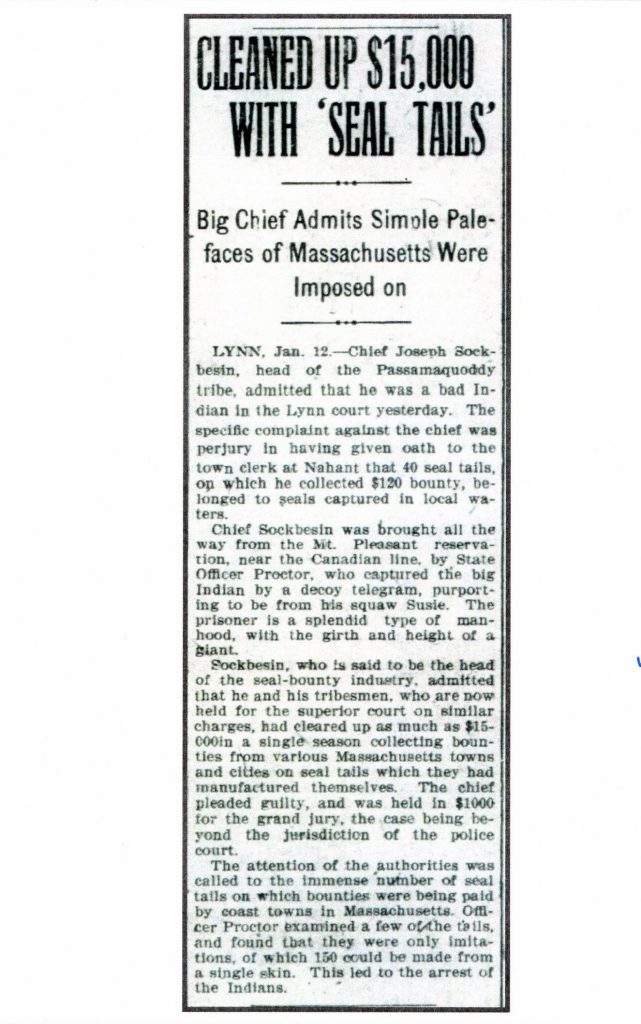
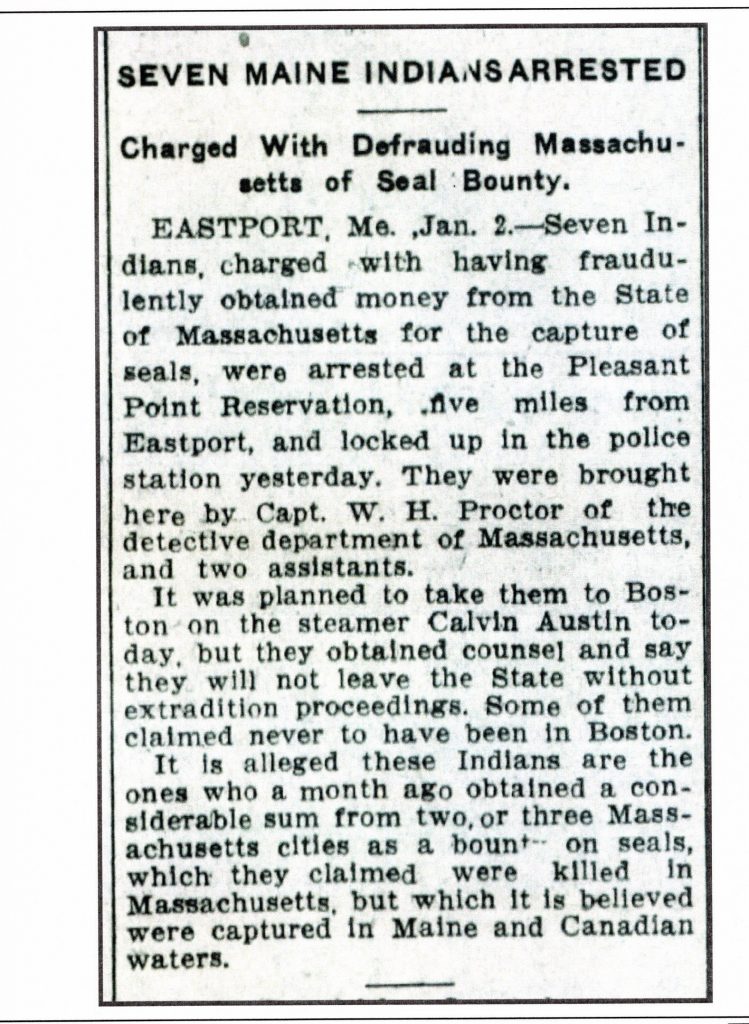
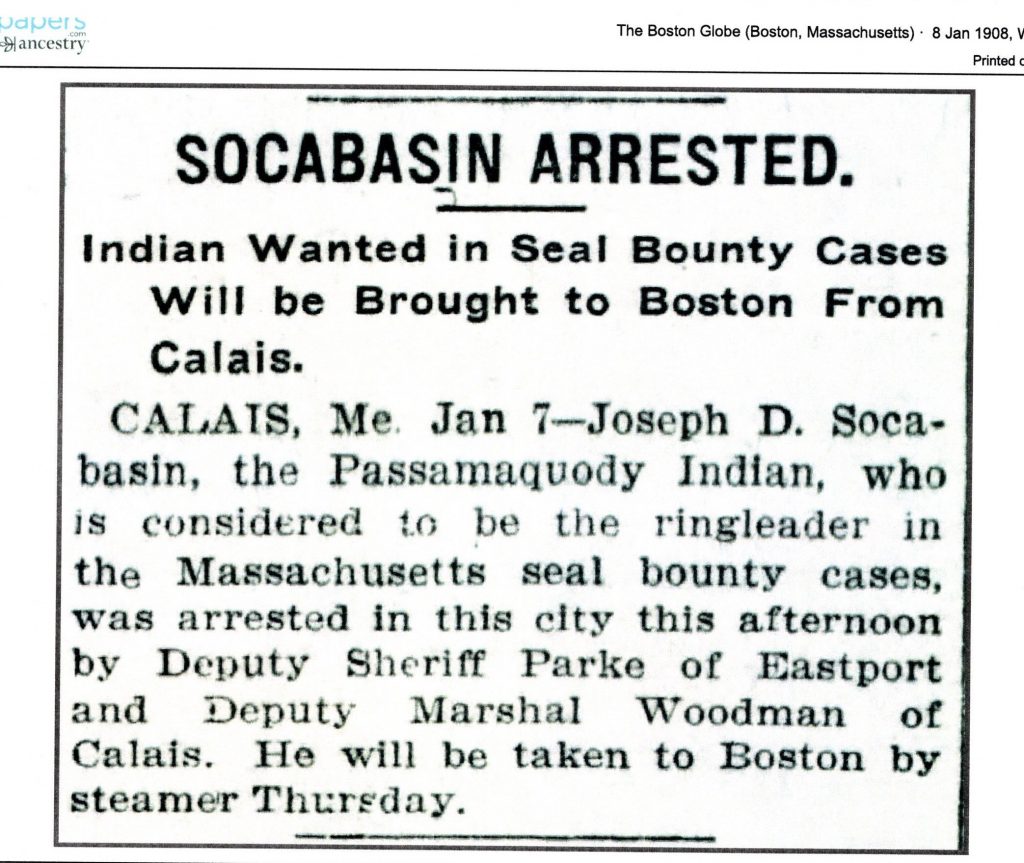
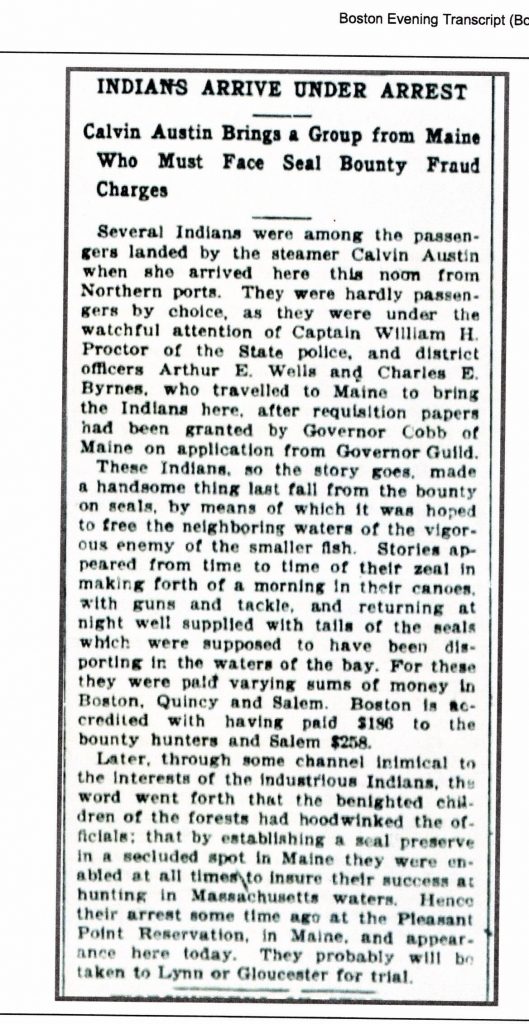
In short Chief Joseph Sockbesin of the Passamaquoddies admitted the tribe had collected about $15000 in bounties-nearly half a million dollars today- by manufacturing seal tails. In Massachusetts collecting a bounty was established by the seal’s tail, not nose. The skilled crafters at Pleasant Point had honed their 1904 technique when they could produce 100 seal noses from a single hide, as in 1908 they could fabricate 150 seal tails from the same hide. The Boston Globe suggested in an editorial that it was time to scrap the seal bounty and many questioned bounties in general as they were abused by not just the Passamaquoddies but many farmers, trappers and hunters.
Although the charges were serious and would ordinarily have resulted in long prison sentences the judge was lenient “because of the ill-treatment suffered by their ancestors at the hands of white people.” Chief Sockbesin was sentenced to 6 months and only one defendant was given a year, presumably because he had collected the most in bounties from the gullible municipal clerks.
